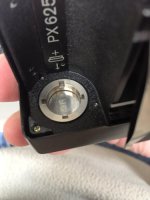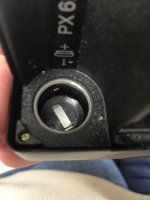...
But I hear you. I covet a C35 for its clean looks and nice handling. (those front dials on the original design don't feel or look good)
...
The design meme for the original Rollei 35 was to hold the camera at waist level when setting exposure and focus. The match-needle meter, shutter/aperture control wheels, and the focus with DoF scale are all set up so you can see them at a glance from the top. When those things are set, you quickly bring the camera to your eye, frame, and make the exposure. Then put it down again. It's an ideal street camera for this reason.
Once you understand HOW to use the camera this way, without prejudices of looking at metering indication and making settings through the viewfinder, you see that most of the control ergonomics are right on the money. The frame counter and hot shoe on the bottom were obviously there because the designer was trying to make the camera as small as possible and wasn't too concerned with flash.
Later models with the LED indication for the meter in the viewfinder were never as clean ergonomically as the original. The 35B and 35C models were far less expensive, plastic cameras by comparison ... completely different from the original 35 (35T) and 35S, with a simple Triotar three-element lens; the entire camera was simplified and redesigned to reduce cost; the centralized viewfinder was likely a matter of cost reduction in making the plastic casting. The 35's Tessar four-element lens and the 35S's five or six element Sonnar lens were far superior. The 35 Classic series moved the hot shoe to the top, which was nice mostly in that they reinforced the very thin top metal and it didn't dent so easily.
The C35 was a totally different camera, totally different design, and (if I recall correctly) was a bought in design from when Rollei acquired Voigtländer designs in the early '70s. Design-wise, it was completely different from the Rollei 35 series, and was released almost a decade later (first Rollei 35s release dates to 1966).
I have been a big Rollei 35 fan and user over the years. My favorite and forever one is a black 1973 model 35S with Sonnar 40/2.8 lens which I've owned since about 1990. It traveled with me all over the world for over a decade+ and is still in 100% perfect working order, has made many many superb photos. I should take it out and do some shooting with it again... The meter is still working fine, and I think I still have a couple of good mercury batteries for it. If not, I have the MR-9 adapter and can use a silver oxide replacement battery. But even if I don't put in a battery, it works great ... and I have a number of excellent metering apps on my iPhone that I can use without having to carry a dedicated meter if I so choose.
Klaus Prochnow wrote an excellent Rollei 35 Compendium book many years ago that is one of my prized bits of photographic memorabilia.
🙂
G



